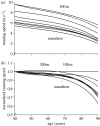Sprint and endurance power and ageing: an analysis of master athletic world records
- PMID: 18957366
- PMCID: PMC2660943
- DOI: 10.1098/rspb.2008.1319
Sprint and endurance power and ageing: an analysis of master athletic world records
Abstract
Human physical performance is notably reduced with ageing. Although the effects of ageing are often compounded by disuse, the study of master athletes provides an opportunity for investigating the effects of ageing per se. It is often held that sprinting is more affected than endurance performance. However, past analyses of master athletic world record data have yielded opposite observations. We argue here that our understanding of these data improves by considering how, biomechanically, metabolic power is related to athletic performance. In line with earlier studies, our analysis showed that running speed declines with age in a more pronounced way for endurance events than for sprinting events, confirming former studies. However, when assessing the metabolic power required to achieve the running world records, sprint and endurance events show a relatively uniform decline with age across the different events. This study has reconciled formerly conflicting scientific results and improves our understanding of the ageing process. However, it is unclear as to which are the governing mechanisms that cause the different systems in our body, responsible for sprinting and for endurance performance, to be affected by ageing in a remarkably uniform way.
Figures



References
-
- Aagaard P., Magnusson P.S., Larsson B., Kjaer M., Krustrup P. Mechanical muscle function, morphology, and fiber type in lifelong trained elderly. Med. Sci. Sports Exerc. 2007;39:1989–1996. - PubMed
-
- Allen W.K., Seals D.R., Hurley B.F., Ehsani A.A., Hagberg J.M. Lactate threshold and distance-running performance in young and older endurance athletes. J. Appl. Physiol. 1985;58:1281–1284. - PubMed
-
- Baker A.B., Tang Y.Q., Turner M.J. Percentage decline in masters superathlete track and field performance with aging. Exp. Aging Res. 2003;29:47–65. doi:10.1080/03610730303706 - DOI - PubMed
-
- Canepari M., Rossi R., Pellegrino M.A., Orrell R.W., Cobbold M., Harridge S., Bottinelli R. Effects of resistance training on myosin function studied by the in vitro motility assay in young and older men. J. Appl. Physiol. 2005;98:2390–2395. doi:10.1152/japplphysiol.01103.2004 - DOI - PubMed
-
- Capelli C., Schena F., Zamparo P., Monte A.D., Faina M., di Prampero P.E. Energetics of best performances in track cycling. Med. Sci. Sports Exerc. 1998;30:614–624. - PubMed
MeSH terms
LinkOut - more resources
Full Text Sources
Other Literature Sources
Medical
Miscellaneous
